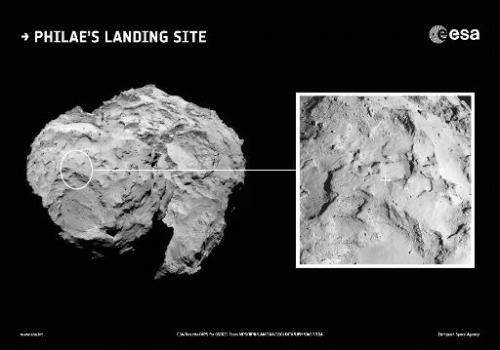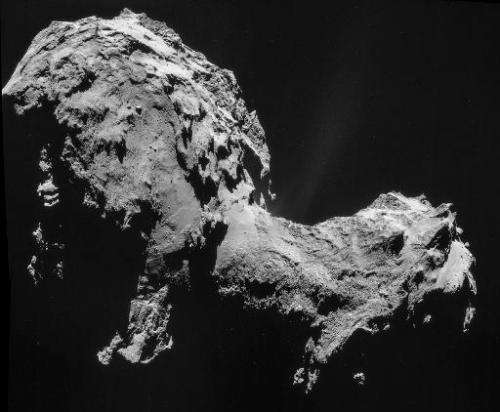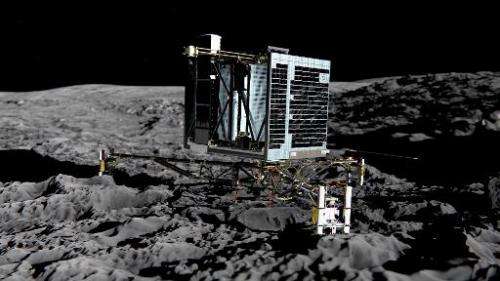'Target locked': Comet mission eyes Wednesday landing

European scientists are gearing for the culmination of two decades' work and a 1.3-billion-euro ($1.6-billion) bet with the first-ever landing on a comet on Wednesday.
In an operation fraught with peril, an unmanned science lab called Philae will detach from the European Space Agency (ESA) scout Rosetta and descend to a comet 510 million kilometres (318 million miles) from Earth.
If all goes well, the 100-kilo (220-pound) probe will harpoon itself to the surface of Comet 67P/Churyumov-Gerasimenko.
It will then carry out experiments that, astrophysicists hope, could be a landmark in understanding the Solar System and the origins of life on Earth.
"Rosetta spacecraft in excellent shape," ESA tweeted on Tuesday. "Target locked!"
In 1993, when the Rosetta mission was approved, the Internet did not exist, Bill Clinton and Boris Yeltsin were in government and the hit movie of the year was "Jurassic Park".
Riding piggyback on Rosetta on a 10-year trek across the Solar System, Philae has travelled more than six billion kilometres to make its historic rendezvous—spending 957 days of its journey in hibernation.
Mission controllers at Darmstadt, Germany, face a series of four "go/no-go" assessments before giving the final command to let the little explorer detach from her mothership.
Darmstadt should receive confirmation of the separation at 0903 GMT on Wednesday.
For veterans of this marathon mission, it will be like the severing of an umbilical cord.
"It's going to be a rather magical moment," said Sylvain Lodiot, ESA flight manager.
Over the following seven hours, the probe will ever-so-gently descend over 20 kilometres to the surface of the four-kilometre-long comet.
It will aim for a landing site called Agilkia, an egg-shaped spot measuring just 900 metres (yards) long by 600 metres wide.
It is deemed to be the least hazardous place on a comet studded with rocks and gashed by ravines and cliffs as high as houses—a nightmare for a fragile lander.
Philae will land at 3.5 kilometres per hour, firing two harpoons into a surface the engineers fervently hope will provide grip.
Ice screws at the end of its three gangly feet will then be driven into the comet, to prevent the labs drifting off into space from an object with negligible gravity.
The size and heft of a refrigerator back on Earth, Philae will weigh just one gramme (0.04 of an ounce)—or less than a feather—on "67P".

Superstition and science
For millennia, comets have been a source of fear and awe.
"The celestial phenomena called comets (excite) wars, heated and turbulent dispositions in the atmosphere, and in the constitutions of men, with all their evil consequences," warned the first-century Egyptian astronomer and astrologer Ptolemy.
Scientists, though, see them differently.
To them, comets are bodies of ice and dust—the ancient, primordial material left over from the building of the Solar System.
Doomed to orbit the Sun, the comets warm as they approach our star, causing a fount of gases to escape from their head, and leaving a trail of ice particles which are dramatically reflected in sunlight.
Some experts believe comets may have helped to sow life on Earth itself.
According to this theory, comets pounded the fledgling Earth 4.6 billion years ago, providing it with complex organic carbon molecules and precious water.

Rosetta has already sent home fascinating data on the comet, but Philae will provide the first on-the-ground assessment, using 10 instruments to study the comet's physical and chemical composition.
Like Rosetta, it will wield a mass spectrometer, a high-tech tool to analyse a sample's chemical signature, aimed at drawing up a complete carbon inventory.
A showstopper find would be molecules known as left-handed amino acids, "the 'bricks' with which all proteins on Earth are built," says ESA.

Comet landing: The interminable seven-hour descent
Ground controllers face a nail-biting, seven-hour wait Wednesday between robot lab Philae separating from Rosetta, its orbiting mother craft, and making its historic touchdown on a comet.
And given the distance from Earth, they will have to wait 28 minutes and 20 seconds for the signal to arrive that everything ultimately went well... or not.
Here is a timeline of Philae's planned descent:
Tuesday November 11:
- 1930 GMT: First "go/no-go" signal is given after a critical systems check to confirm Rosetta is on the correct trajectory to set down its precious payload.
- Midnight GMT: Second "go/no-go" confirms that the instructions for Philae's separation from Rosetta, and its landing on comet 67P/Churyumov-Gerasimenko, have been correctly uploaded. Rosetta is ready.
Wednesday November 12:
- 0135 GMT: Third "go/no-go" to confirm the health and status of Philae. The robot is now ready for landing.
- 0603 GMT: Rosetta performs the final pre-delivery manoeuvre to place it on the correct trajectory at a distance of 22.5 kilometres (14 miles) from the comet's centre.
- About 0635 GMT to 0735 GMT: The final "go/no-go" decision on lander separation—the final verification that Rosetta, Philae, the orbit, the ground stations, ground systems and the teams are ready for touchdown.
- 0835 GMT: Philae must self-eject from Rosetta to start its seven-hour descent to the comet.
- 0903 GMT: If all has gone well, the signal from Rosetta to confirm Philae has separated should arrive on Earth.
- 1053 GMT: The first signal from Philae, sent via Rosetta, are scheduled to arrive on Earth. This will indicate that the two craft have successfully established a communications link.
- Around 1534 GMT: Philae lands on 67P.
- About 1602 GMT, with a one-hour window: The signal confirming touchdown arrives on Earth—ending an anxious wait for ground controllers four times longer than the so-called "seven minutes of terror" it took for the signal from the rover Curiosity to arrive after it landed on Mars in 2012.
- Philae is meant to obtain and transmit the first images of 67P's surface almost immediately after landing, and get started on its science experiments for a mission of at least one week.
Rosetta and Philae: 10 figures
Ten facts to sum up orbiter Rosetta and robot lab Philae, Europe's comet-chasing duo:
- 10 years and eight months: How long Rosetta and its payload Philae have been in space since launch on March 2, 2004.
- 6.5 billion kilometres (four billion miles): The distance they have travelled.
- 510 million kilometres (320 million miles): Current distance of comet 67P/Churyumov-Gerasimenko from Earth.
- 18 kilometres per second (11 miles per second): The speed at which the comet and its orbiter are zipping towards the Sun.
- 3.5 km per hour (2.2 miles per hour): The pace at which Philae should ease itself down onto the comet on Wednesday.
- 22.5 km (14 miles): The approximate height at which Rosetta will release Philae.
- Seven: Philae's journey time in hours to the comet surface—and roughly the number of days it will be able to work without a solar recharge.
- 28 minutes and 20 seconds: The time it will take signals from Rosetta to reach Earth.
- 1.3 billion euros ($1.6 billion): The total cost of the mission—equivalent to the price of about four Airbus A380 jetliners.
- 10: The number of science instruments onboard Philae, adding to 11 on Rosetta.
© 2014 AFP





















